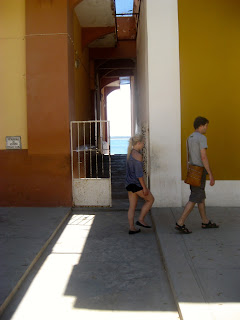The Deserted Island
September, 2013
Walking through the
streets of Isla de Mozambique feels like walking through a museum that hasn’t
been curated or cared for in years. The houses look like they should be
beginning to crumble yet they stand defiant, proud and strong in the face of
years of neglect. Hugging the island are beaches, graced by white sand,
unspoiled and ungroomed, and blue water, warmed by the sun. Connecting one end,
where you can find the grandiose abandoned houses of the Portuguese, to the
other, where most of the Mozambicans live in shacks with tin roofs, are dirt
roads flanked by concrete sidewalks, varying in quality and the number of
potholes. There are a few modern fixtures, including a nightclub and a cell
phone store, but most of the island seems to be from a different era.
Isla de Mozambique was originally an island held a Bantu
tribe. In 900 AD it was occupied first by Arabs, looking to set up trading
posts and then by Portuguese, for whom it was a key trading post en route to
India. Following a prosperous period marked by economic expansion and
architectural development, including the building of mighty fortresses that
remain today, Isla fell into decline in the 17th century. But as the
demand for slaves across the world grew in the second half of the 18th
century, so did Isla’s economy. When the capital of Mozambique, a colony at the
time, was shifted to Maputo (where it remains today) the economy again slowed
down. But what truly brought Isla down to its knees was the sudden evacuation
of Portuguese, many of whom identified themselves as Mozambican at the time, at
the time of independence. In 1975, FRELIMO, in what Wikipedia has coined “an
act of vengeance”, ordered all Portuguese to evacuate the country within 24
hours with only 20 kgs (44lbs) of belongings. Houses were locked up and
abandoned and many seem to remain untouched from that day.
To me though, Isla de Mozambique was a soft bed at the end
of a long journey, a cold drink after a rough day or a refreshing dip in the
ocean after toiling in the sun. It was, in a word, paradise. I wake up early,
when the sun wasn’t yet too hot, and go sit on the roof of the hostel and read
a book with my coffee and cigarettes. The sun kisses my bare arms and legs and
my eyes begin to get heavy and the words in my books turn to cloudy drops of
ink and eventually and inevitably, I doze off.
In my sleep, I find myself walking through Isla in its many
high points. The houses, splendid in their size and architectural design, tower
above me, not like NYC skyscrapers in their steel casings and sharp corners,
but more kind and soft. The hustle and bustle of the streets is full of energy
and vibrancy. The parks are teeming with children, holding hands, skipping and
singing, as kids can only do in dreams. I walk along the carefully manicured
streets and under the shadowy protection of trees but the further I get away
from the houses, the more the scenery changes. Suddenly, I find myself at the
tip of the island where the fortresses are. They seem to be flexing their
muscles with their high walls and circling guards but I’m not the threat. They
face outwards at the sea, keeping an eye out for intruders. I turn and slowly
wander away from the fortresses and the stone houses and the transformation is
immediately obvious. No longer is the street teaming with Portuguese dressed in
elegant summer clothes bristling with excitement at the debutante ball
tomorrow, but instead its crowded with Mozambican men carrying recently caught
fish, kids playing with homemade toys and women headed in the opposite
direction, on their way to work in the houses of the rich. Where the houses
were once stone, they are now straw. It isn’t a depressing scene per se but
there is a tangible difference from earlier.
When I eventually rouse myself from sleep, it’s time to
explore the depths of the island and to go for a swim in the Indian Ocean. The
heat has gotten intense now but the weather is dry and there’s a light breeze.
This isn’t the NYC heat that makes your clothes cling to you and your hair
stick to your forehead within minutes. Instead it’s a pleasant heat. Granted,
it’s the winter here and I can’t imagine how hot it gets in the summer but for
now, its bearable and even enjoyable.
The first few days, the streets were usually pretty empty,
save for a few kids fooling around and some stray dogs. The dogs were
particular fun to watch. They had their block that they guarded so that if you
wandered onto it, you would immediately be surrounded by barking dogs. But they
kept their distance and never got close enough to feel properly threatening.
All bark and no bite.
Finally I reach the dock, strip down to my bathing suit,
carefully climb down the stairs and dive in.
__________________
For any other information related to this piece, feel free to leave a comment or to contact me via email, via twitter or any other imaginative way you can think of!
If this is your first time here, check out my Introduction to the Blog and Introduction to Africa.
__________________
For any other information related to this piece, feel free to leave a comment or to contact me via email, via twitter or any other imaginative way you can think of!
If this is your first time here, check out my Introduction to the Blog and Introduction to Africa.





No comments:
Post a Comment